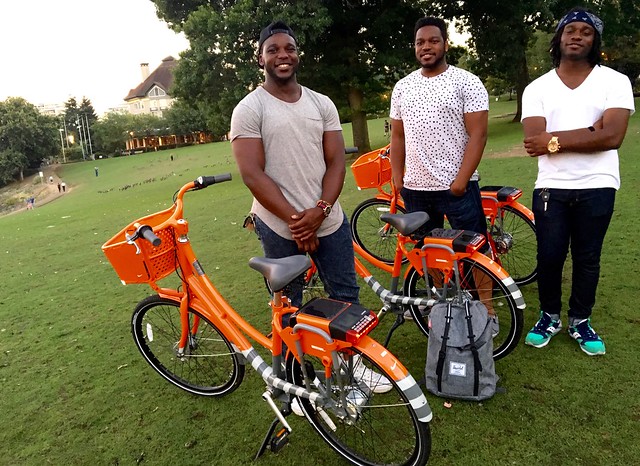
(Photos: J Maus/BikePortland)
This article is by Jessica Roberts, a principal at Alta Planning + Design and resident of north Portland. She previously wrote about a local bike racer and infrastructure on North Williams Avenue.
To the average Portlander, it must look like they just dropped from the sky overnight. Or perhaps like an exotic fungus that sprang up from the ground over a particularly rainy summer evening. I’m talking, of course, about one thousand bright orange Biketown bikes that have already – just one month into the program – become nothing short of cultural phenomenon.
How could a simple fleet of bright orange bikes make this big of a difference?
Sasquatch has ridden one. So has a Trailblazer (whose Instagram video received over 34,000 views) and a Grimm star. One woman learned to ride a bike on one. And at this point, the question might not be whose dog has ridden in a basket, it might be whose dog hasn’t. Social media posts are full of statements like “Maybe the most fun I’ve had in a year!” “These bikes put a smile on my face,” and “This. Is. Awesome!” In the first three weeks alone, bikes were ridden over 108,000 miles.
Take a moment to let that sink in. And ask yourself: when was the last time your city did something for bikes that made such an immediate and positive impact? Thanks to Biketown, the image of bicycling has changed, seemingly overnight, from being an insiders-only activity to something that everybody – elected officials, tourists, construction flaggers, conference attendees, first dates, visiting family members, businesspeople – wants to do.
Now ask yourself: How does this even make sense? It just isn’t that hard, or that expensive, to get a bike. Most people already know how to ride a bike. And in lots of US cities, the infrastructure is getting better every day. So how could a simple fleet of bright orange bikes make this big of a difference?
Behavioral economists have an answer, so I invited Elizabeth Linos of the Behavioral Insights Team (BIT) to help me make sense of Biketown’s massive impact. Her job is to figure out the deep, and often invisible, factors that actually cause people to change their behavior – not what they think, or what they wish, but what actually is going on in their brains. And she does that with science, naturally.
BIT has come up with a way to talk about the science of behavior change, using something they call the EAST framework. To summarize: to help people try a new behavior, you must make it Easy, Attractive, Social, and Timely. These very factors explain how bike share can be so revolutionary.
But first, let’s take a look at who’s riding Biketown…
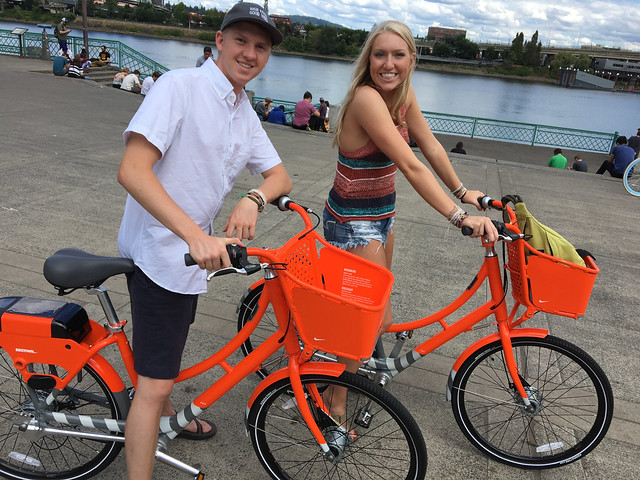
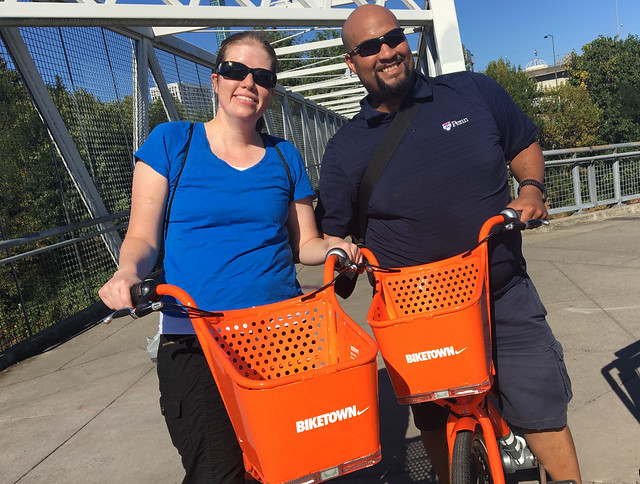
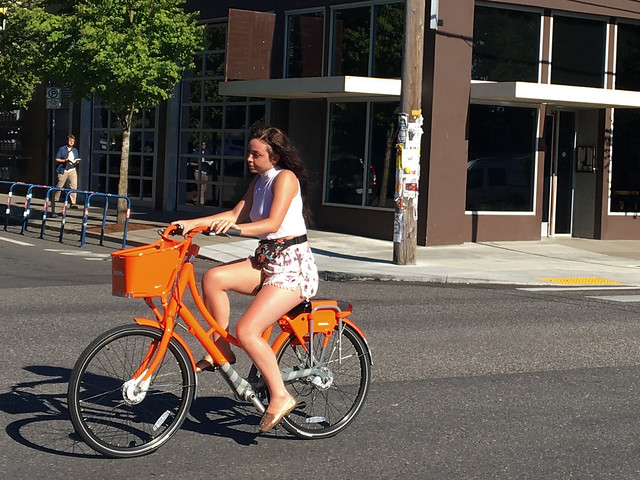
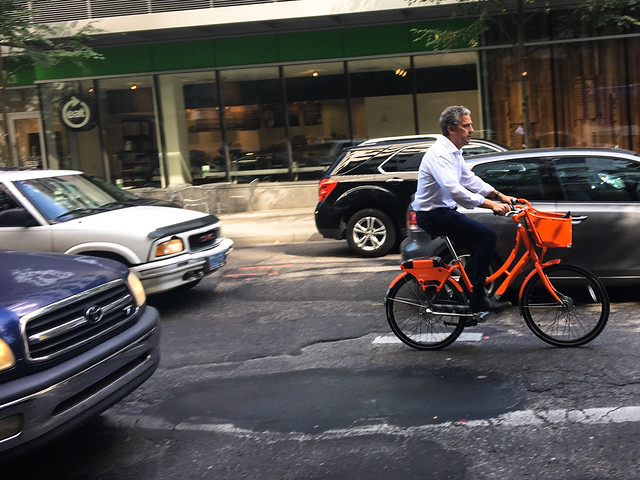
OK, as I was saying, the BIT talks about the science of behavior change via the EAST framework. To help people try a new behavior, you must make it Easy, Attractive, Social, and Timely.
Make it Easy: Biketown is easy. It’s easy to sign up on your smart phone. It’s easy to find a bike thanks to a well-designed mobile app, and because you can’t turn a corner without finding one. It’s easy to type in your code and bike off. It’s easy to carry stuff (basket!) and not worry about gear (no helmet law, no greasy chain, and the lock is built in!). All of these factors reduce the barriers to giving the service a try.
Make it Attractive: Whether you like the color orange or not, you can’t deny that the impact of 1000 bikes are eye-catching. The bikes are stylish and fun, and the official and user-generated social media output feels appealing and current. An attractive system is more likely to inspire people to take action.
Make it Social: Between the bright color, the social media frenzy, and the impact of seeing dozens of smiling folks on every time you’re out and about, you really feel like “everybody else is doing it – I don’t want to be left out!” This feeling – shall we call it Biketown FOMO (fear of missing out)? – has been shown to be a powerful motivator to get on board.
Make it Timely: Even if everything else had gone well, a January launch would not have led to immediate headlines like this one. By launching the program in the summer, people would have the ideal weather to try it out, are more likely to see other people using it, and are more likely to be on vacation or at least in a relaxed frame of mind. Launching at the right time set the program up to be an immediate success.
Linos understands that these factors all work together to make bike share the ultimate vehicle for change. She says, “The launch of bike share shows that cities can often nudge people into better health and more sustainable transport without always relying on regulation or law.”
Thanks to a system that follows the EAST principles, ordinary people in our city – ones who don’t think of themselves as “bike people” at all – see Biketown bikes everywhere, perceive that it’s fun, normal, and desirable, and find it easy and rewarding to sign up and get on a bike. If we want to make our cities better places, we just need to make all of our programs as easy, attractive, social, and timely as Biketown.
– Jessica Roberts, @jessicaroberts
Jonathan Maus and Ted Timmons contributed reporting to this story.
BikePortland is supported by the community (that means you!). Please become a subsriber today. You can also make a one-time donation here.


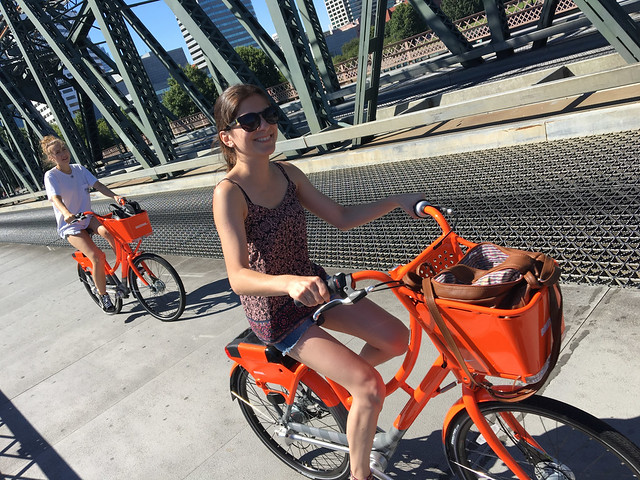
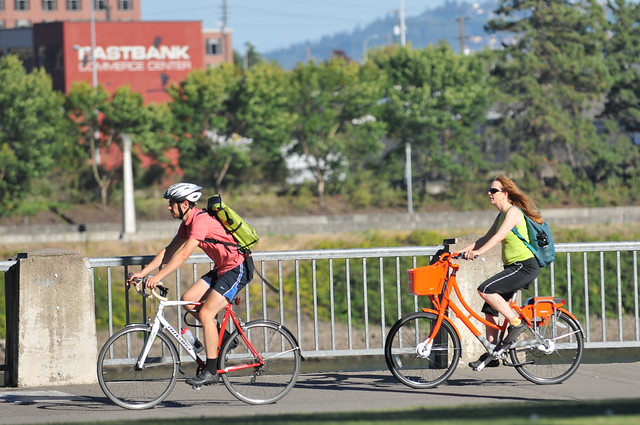
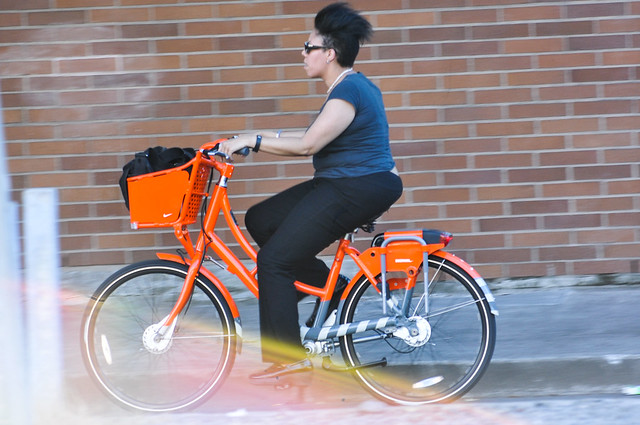
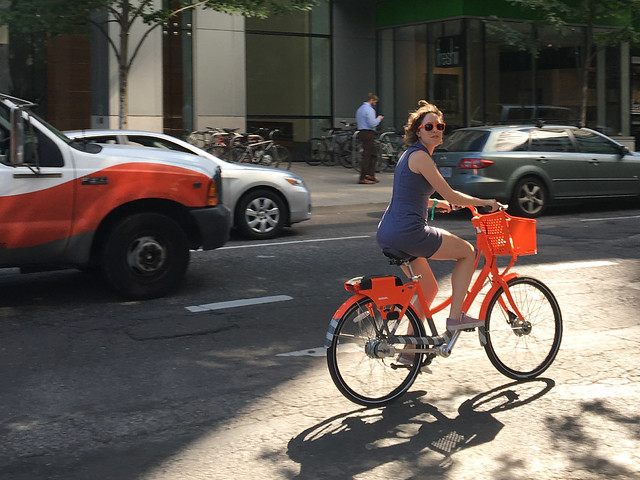
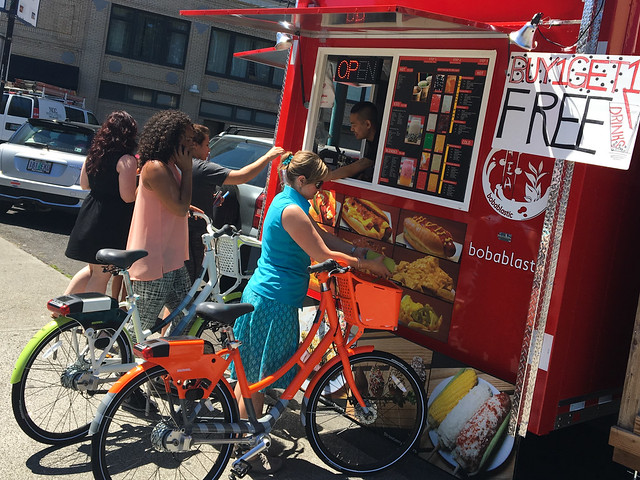


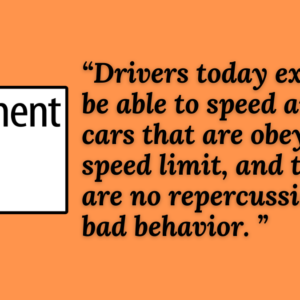
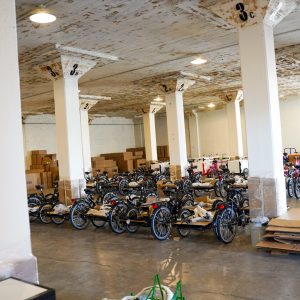
Thanks for reading.
BikePortland has served this community with independent community journalism since 2005. We rely on subscriptions from readers like you to survive. Your financial support is vital in keeping this valuable resource alive and well.
Please subscribe today to strengthen and expand our work.
>The proportion of women on Biketown that are dressed casually and not wearing helmets is off-the-charts compared to what you see on regular bikes. And that’s a very good thing.
Why? And why the chauvinism? Isn’t this phenomenon seen across both sexes?
Hi Stuart,
Good questions.
I think it’s a good thing because it shows women feel comfortable enough to ride these bikes in regular clothes and without a helmet — two indicators that they perceive the activity as being completely safe and normal.
And anecdotally I’ve seen way more women riding these bikes without helmets than men. I also specifically refer to women because they typically use bikes at a much lower rate than men.
I hope that clarifies for you. If not, let me know.
>And anecdotally I’ve seen way more women riding these bikes without helmets than men.
Interesting.
https://www.portlandoregon.gov/transportation/article/545858
“Overall, women wear helmets at higher rates than men . Citywide, 87 percent of women counted were wearing helmets; 78 percent of men counted wore helmets.”
I don’t see how this is either good or bad.
What it suggests is that the share bikes are being used casually rather than as workhorses. There are more male than women cyclists, but there are explanations of this rather than fear (why is it not sexist to assume fear holds back women so much).
As someone who has worked in a female dominated industry for 20 years, the reason I am given most often for why they don’t bike by far is that it messes up their appearance (particularly their hair). Safety is on the list, but getting messed up is a much bigger deal.
Also, gender patterns relating to employment and responsibilities make a difference. I passed a woman today hauling 2 kids on a bike. Few people are that dedicated.
But I agree with the general with the idea that if you make things easy, people will do it. They’ve done a great job with the bike share program though I hope they expand coverage dramatically.
In explaining yourself, you’ve missed the point: the caption says little more than “it’s nice to see women biking.” If, in fact, a significant proportion of new Biketown riders are women, and those women are wearing their helmets significantly less than other riders, that’s bad news… unless you’re anti-helmet.
I’ll take your question at face value and not some MRA pushback. If you’re interested in learning more about why some people might care specifically about women riding bicycles, you could start by reading this Scientific American article, “How to Get More Bicyclists on the Road”:
http://www.scientificamerican.com/article/getting-more-bicyclists-on-the-road/
Hope that answers your questions.
Traditionally underrepresented groups are increasing their participation. It is happening suddenly, organically, and far more effectively than years if not decades of outreach.
Is that *not* significant and positive?
Okay okay I get it! I didn’t fully understand why people were so excited about bike share and what it could do for the city, but now that I’m seeing people riding them all over and having just read this post I’m a bike share believer.
I’m in the same boat. Still reserving judgement, but I like what I see.
Regarding 108,000 miles getting you to the moon and back three times.
You’re math is off by a lot, 108,000 miles is not even halfway to the moon.
ack! editing that now. thanks TVCB
Pedantic editorial comment: Trail Blazer is two words. Great article!
So instead of 3 weeks, it’ll take 8. Nobody expects these bikes to be fast! 🙂
Here’s hoping Biketown will be a catalyst that pushes Portland from a city of bike dorks to one where cycling for transportation is considered mainstream.
PS: I love all of you bike dorks. 😉
I’m a level 5 dork…my bike casts no shadow.
I wish I could hit the thumbs up button more than once.
This dork biker rides slow, notes lane widths where working or lacking, dreams of freight Trikeway corridors meeting rickshaw ways and high-speed bikeway ramps and viaducts to bike city center districts closed or readily closed to traffic. These new riders have found how a relatively safer bike infrastructure is created. The opportunity here is to continue taking bold steps once and for all to finally consider ‘bicycling’ as a “fundamental” mode of urban/suburban travel necessitating extensive investment in bike-specific infrastructure.
I noticed all the bikes on N. Mississippi in front of Prost were flipped again early yesterday morning. Is there a possible fix for that?
People are still doing that? Damn.
Thanks for another illuminating and well-written article, Jessica!
I have been seeing more and more people riding down NE Davis lately. I’m stoked to see people riding through neighborhoods and checking out the city, and not just riding downtown and other “market” areas. Great start, IMO.
Just another example of how awesome Nike is!
It will be interesting to watch the most important metric: “rides per bike per day” over time. At 1.9, it is more than most in the US (as would be expected from one of the bikey-est towns in the US), but less than (rough numbers from the ITDP Bike Share Planning Guide): Barcelona (10), Lyon and NYC (8), Rio and Montreal (7), Paris (6), Mexico City (5), Boston (4), Denver and London (3), and Madison and DC (2). Is Portland more bikey than these towns? Less? Will daily trips per bike increase as more people learn about it or decrease as the weather worsens?
Looking forward to seeing what happens!
I’m curious to see, over time, how the rides per day translate to financial performance. How does BikeTown stack up vs TriMet etc from a profitability/subsidy standpoint? Not saying it needs to be profitable, I’m just curious about the financials of it. It’s a great addition to the City!
Conveniently, Better Bike Share just did a bunch of math on what the per-ride cost of bikeshare is, and the answer is …. very, very little. http://betterbikeshare.org/2016/08/16/much-bike-share-ride-cost-system-lets-math/
From a subsidy point of view Biketown is blowing Trimet out of the water. No city money is being spent on it at all. There was some money to get it started from a federal grant and a little from the state to build a specific station but operating costs are being borne fully by user fees and advertising sales (Nike).
That’s great for the young and/or ambulatory.
For the aging or disabled parts of Portland’s population, not so much.
Which is why I find this comparison a little dubious, and potentially worrisome. Public transit is already under attack from the automobile industry and federal funding cuts; should we just let it die altogether?
It’s not an either-or situ.
We absolutely need better public transport.
My dad is an amputee in his 70s who rides bikes regularly and is about to do the portland marathon. A couple years ago we rode from Pittsburgh to dc on rented bikes. Biketown may not be for everyone but plenty of people who are older and or handicapped can and will use the system.
Yes, totally agree – the astonishingly low cost per ride / public subsidy needed is a terrific selling point for bikeshare and we should make a big deal out of that. But it can’t stand in contrast to the cost of providing transit. There is no scenario where bikeshare can or should replace transit. On the contrary, it’s beautifully complementary to transit – solves first/last mile problems, can fill in certain trip types that re ill served by transit, can shave off peak-hour crowding….but it will never replace transit and we shouldn’t frame it thusly.
Bjorn, Trimet is accessible. Bike town is not. I think that tends to disqualify you from receiving any federal money.
DC’s bikeshare’s stance on this is that it’s part of a transportation system; it’s one component, just like buses and subways and dial-a-ride.
Trimet is more accessible to people who are in wheelchairs I agree. However if you are confined to a hospital bed trimet won’t work for you any better than biketown. While there are a small number of people who can’t use bikeshare to say that it isn’t useful for people who are handicapped and/or elderly is simply not true. There are lots of elderly people who are completely capable of riding a bike just like there are lots of handicapped people who are completely capable of doing so. Biketown already got some federal dollars, so it obviously isn’t a complete disqualification, however since it is so cheap to operate the need for federal funding also seems a lot lower.
Oh my god! Seriously, Bjorn. Wheelchair vs. hospital bed, *that’s* your argument? So… The rest of us just don’t exist, right?
“The rest of us”
Can you elaborate?
I think Bjorn’s point is a good one. In this unbikey country we all too often mix up
(a) has no experience biking, has no peers who bike, is cowed by the very idea ob sitting on a bike, and
(b) is physically unable to ride a bike because of a disability, infirmity, balance issues, or whatever. Since we (some of us) seem to know people who are not only old but handicapped who ride far and long, perhaps this fact can be allowed to intrude on the all too familiar if also a bit too broad brush ‘many people can’t bike’ assertion. Didn’t we just read here the other day that the percentage of handicapped people who ride bikes in the US for transport (15%) is indistinguishable from the percentage who are not handicapped? Perhaps I’m misremembering this.
If you’d been paying attention, you’d have seen that Bjorn only two examples of disability were “in a wheelchair,” and “in a hospital bed.” As if those were the only two possibilities.
As for whether or not you just read here the other day that “the percentage of handicapped people who ride bikes in the US for transport (15%) is indistinguishable from the percentage who are not handicapped?” I have no idea. I try not to spend much time here. I only check in here occasionally when there is a specific article I’m following. This community leaves a bad taste in my mouth.
Come on in, Serenity Ebert… the mud is warm. It beckons to you.
For those interested, the federal National Transit Database ( https://www.transit.dot.gov/ntd ) makes the financial performance of public transit systems pretty transparent, and includes a couple of different slices of the data at operating expenses per vehicle/passenger.
Trimet:
https://www.transit.dot.gov/sites/fta.dot.gov/files/docs/00008_0.pdf
City of Portland (Streetcar):
https://www.transit.dot.gov/sites/fta.dot.gov/files/docs/00058.pdf
Those numbers look like rank values on a list, not actual ride per bike per day values. Is that right?
Then there is the system size, tourist factor, and population difference to compare.
Just had my first experience with Biketown this week. I rode my own bike, but had three friends visiting from out of town. (Washington DC, two from Europe) I told them about the website and they said it was very easy to figure out, get a code for a single day the night before online. They had ridden other bikeshares (including capital bikes) but none with our style system (which was preferred) and liked having more than 3 gears and the clever integrated bell.
I think the other big benefit of the bike share is getting your bike to where you want to use it even if you own one. It is easy to bike the waterfront on your own bike if you live in Ladds Addition or are an experienced rider who can ride across town from Cully. But for many people they don’t have the car infrastructure to haul their bike in from Hillsboro, or the skills and strength to ride in from Lake Oswego. Bike share solves the problem of getting a bike to where you want to ride.
Bike share also works great as a supplement to our mostly-mediocre bus service. Off-peak-hour multi-bus journeys often require a long wait between transfers. I often find myself taking bike share to the second bus line, rather than taking both buses. Also, if I miss the last bus, I can pay $10 to ride all the way home. I have yet to do this, but knowing I can is a huge relief. I can’t wait for the day I can take bike share to the Red Line to the airport.
We live downtown and see lots of these! I can’t tell if the users are out-of-towners, or residents, but either way, they are everywhere in the Pearl and on NW Naito.
A part of me wants to do a small eye-roll at the whole thing, but most of me is happy to see people who you can 100% tell would NOT normally be on a bike, well, being on a bike.
99% of them are probably drivers, and I think it’s so awesome that they are on bikes, even for a day. Because they get to experience what it’s like to be on a bike – the good, and the bad.
I hope that they morph into more careful drivers around cyclists, because hopefully, they can for the first time in their lives, relate to what it’s like to BE a cyclist.
I would normally be on a bike, but I used Biketown 4 times in 1 day last week. The demographics are probably spread wider than we think.
The gallery reminds me of Copenhagenize. That’s a compliment. It shows ordinary people getting around on bicycles. I’ve commuted by bike for years and I have a much longer history of enjoying bicycles for fitness, touring, etc. I never thought I’d have much need for a bike share program here. I was wrong. There are times when my commuter bike is at work and I’m at home, needing to get to work. I walk down to the corner to a dock, pick up a bike and get to the job for the same cost as riding the bus. I would add that Biketown customer service has been very good. A kiosk ate my credit card. A representative was there in less than 10 minutes, retrieved my card, and I was on my way.
I’ve already seen more people using the orange bikes than I expected. Hopefully, it will continue increasing.
Just for the sake of comparison, please keep in mind that there are about 10,000,000 miles driven within the city limits of Portland on a daily basis. So, there’s plenty of travel demand out there currently using autos that can switch to bikes.
I’ve seen more than I expected, I think. In any case, a million minutes in the first few weeks is nothing to scoff at; it’s nice to have a program that is immediately successful.
Does anyone have an estimate for how many miles are generally biked per day in Portland? If 7% is the per-trip (commute only?) mode share, how does trip length factor that vs overall VMT?
I was hugely skeptical of Biketown — mostly because I saw it as a huge endeavour benefiting tourists more than Portland locals… seeing its popularity and success has really altered my perspective.
That being said, I’m seeing a lot of riders taking sidewalks on major thoroughfares where I live in Buckman. I’m often tempted to reach out when I can to let people know there are better, more enjoyable routes on the greenways. I’ve only briefly glanced at the maps installed at the bike racks. They indicate greenways, right?
I see this with other tourists riding around on bikes rented from other private companies: couples in shorts, sandals, no helmets, riding down Hawthorne or Chavez, either in the sidewalk, or more frighteningly, down the main thoroughfare. I wish there was better signage pointing them to friendlier bike routes. These signs are ubiquitous on bike paths but, as far as I can tell, they’re non existent on major streets.
This is great! Tourists paying to come and be our traffic calming. I say bring it!
They are riding on the sidewalks of the major streets because that is what makes the most sense to them, because that is where all the destinations are. PBOT would rather they be hidden on the greenways instead, but this makes no sense if they are looking to explore Hawthorne/Belmont/etc. by bike. This is why we need dedicated bike infrastructure on our destination streets.
I’ve also been wondering what kind of educational outreach would be possible for people using these bikes. Yesterday I watched a group of four presumably out-of-towners wobble down NW 11th in the streetcar lane, trying to avoid the parked cars and the tracks. I followed them in my car for 2 blocks and saw them get their tires stuck twice (though they were going so slowly they were able to just put their feet down and pull out).
OK. good response during nice weather.
JM, could you update those stats at EOY ?
The bikes do look sharp, and their design reflects some good, well thought out engineering, but the 60lb weight and ‘one size fits all’, sounds like things that would take some of the fun away.
I had to drive from the Beav on Monday, to east Burnside. There were some people some of them women, out riding the bikes, and that was encouraging. Back on the west side on 3rd, there was a woman clipping along pretty good, 12-15 mph on 3rd.
Rainy, cool to cold fall and winter weather will be better conditions for gauging how enthusiastic people are about using bike share. Rainy mucky weather, seems like it would make for quite a challenge to keep the bikes looking sharp.
I’d be more inclined to think people riding bike share, aren’t wearing helmets at the rate they do when riding their own bikes…not so much due to that they feel comfortable or well enough protected riding the bikes without helmets, but because it’s probably kind of a hassle for people to carry a helmet around in the event they decide to ride a bike share bike.
And also perhaps because some of them, may not well understand the potential for close calls, crashes and collisions…as traffic-wise regular commuting riders may.
“but the 60lb weight and ‘one size fits all’, sounds like things that would take some of the fun away”
Not as much as you’d think. The one-size-fits all scheme is only a problem with hunched-over racing bikes. WIth the more upright position of these cruiser-type bikes, sizing for top tube length becomes much less important, and it’s all about seatpost height, which is adjustable over a wide range on these bikes.
They are a bit slow on the climb, but I think this is due more to the 8-speed hubs’ inefficiency in the lowest 4 gears than to the weight of the bikes. I still wonder if 3-speeds (or the relatively rarer 5-speed hubs) might have been a better choice. On relatively flat ground these bikes feel plenty sprightly, and I didn’t find them slow or not-fun.
Not everyone equates fast speed with fun. I enjoy riding slow.
Nor fun with distance. My favorite rides are where I never leave the yard.
Annual member here….love i! Sometimes I will bike to work and the walk home just to mix it up a bit. Or to think about it another way, I will bike to go for a walk. Multimodal!
I like the orange bikes. Looking at my history, it appears that I ride about twice a week so far. I want to use the bikes more often, but since the coverage area ends about 10 blocks short of my house, I’ve mostly ridden it to connect to the bus or train to take me the rest of the way home.
Either way, I am now really spoiled for transportation options. I have 2 bus lines, a train, car-share, bike-share, my own personal bike, taxis all within walking distance, and an app that summons any of those services.
I wish everyone was so fortunate in this regard.
Question about the stats….it says 1.31 million minutes ridden, but perhaps that’s 1.31 million minutes “on the clock” so the average speed when moving is a bit faster?
I’m guessing 8 is the average speed of movement and the time is lost to red lights.
Yeah, those are “billed minutes”, not time in motion.
I’ll also note that when you reserve a bike, the clock starts ticking, even before you’ve picked it up. This probably doesn’t skew the stats much, but just want to be thorough.
My concern is no helmets. RIding in Portland is challenging with traffic at times.
Helmets do little to protect against thousands of pounds of steel. Further, the safety record of bikeshare suggests your concern is unfounded.
Helmets are irrelevant to bike share safety. Meanwhile, bike share itself has shown to increase safety for all bike users.
http://greatergreaterwashington.org/post/23255/bike-sharing-means-more-head-injuries-study-says-actually-its-the-opposite/
Fortunately, you can wear a helmet if you want to. I am not concerned about other people wearing helmets or not, because that is their decision to make, and has no affect on my life.
Fellow citizens that choose to drive excessively large vehicles and/or drive dangerously in the city are a concern that I have, because that affects my safety.
“My concern is no helmets. RIding in Portland is challenging with traffic at times.” lori
It only hurts if you fall of the bike and smack you’re head on the pavement or on something else. The odds of that not happening can be very good though…until it happens, upon which the odds become a moot point as the person having fallen, nurses their health back from a concussive blow to their head…and there are people willing to take the chance that they won’t fall.
People planning to use bike share, carrying along a personal bike helmet for that use, could be a bit of a hassle, but I can visualize the resourceful among them adjusting to this basic preparation just fine. Bike helmets weigh very little. They occupy some space when not being used, but things can be carried in them.
Biggest helmet related issue may be helmet use for young people 16 and under that might want to use bike share. I forget the age requirement for renting a bike share bike…18?…but there are some very big 12 to 16 year old kids that could ride these bikes if a person of the age requirement were to rent a bike for them; for example, a family here to tour the city, etc. Oregon law requires that they wear bike helmets when riding a bike, and wear one they should.
Wait a sec.. “Trips by monthly pass holders: 11957”. I thought you could only buy a single ride, day pass, or annual. How do you get a monthly pass?
Probably a misnomer. It’s an annual pass but billed by the month.
But it also shows the stat “Trips by annual pass holders: 17085”
“monthly” should be daily. fixing. since they are my numbers I’m pretty sure 🙂
I’ve stopped and talked to about a dozen users of the system to get some informal feedback on why they’re using the system and how they like it, and the monthly/annual issue seems to confuse people.
Calls asking whether we rent bikes -we don’t- have dropped to zero since the arrival of the Orange Bicycles. It doesn’t hurt us, but I wonder what impact it’s having on places that *do* rent bikes.
Hope they’re doing OK.
I love local bike shops, I totally do. (Proof: I don’t even use my BTA discount, because who wants to cut LBDs already razor-thin profit margins?) But I have to say that the daily rentals business is really…not good enough from a consumer POV. You have to get your butt to one of the relatively few shops that offers rentals, plunk down a deposit, bike away from that location even if you’re not comfortable doing so, and the cost has always seemed really high (esp. compared to an auto rental). It sort of feels like the taxi industry in that it is an industry ripe for ‘disruption.’ Spinlister, like BIKETOWN, offers so much more convenience, even if you only think of the convenience of being able to pick up near where you are. We can’t innovate without impacting the status quo. Hopefully most shops that rent bikes also have other income streams, or offer a unique product that’s still valuable (e.g. MTB or tri bikes).
My brain is having trouble holding the ideas of a BikeTown and Rivendell bike simultaneously. Perhaps the callers had no idea what they were asking to rent.
To me “science” means Richard Feynman’s Lectures on Physics.
Not a whole lot of that on BIT’s website.
That’s awesome. Glad to see the Portland bike share succeeding.
Our bike share in Vancouver (Canada) launched around the same time but the roll out has been slow. Only about half of the stations are setup. But the initial data is showing around 3 rides per bike.
Great article! The increase in valuable studies about how people actually behave – as opposed to, for example, how classical economics models say they should behave – has been one of the best developments of the past 15 years or so.
I’m a daily bike commuter in Eugene & tried Biketown today on a day trip (dropped people off at PDX). It was easy to use although the upright/clunkier bike took a bit getting used to riding. I’ve used bike share in DC, Chicago & Boston as a visitor and it’s a great way to get around a city, paired with other public transportation. Biketown was the best experience I’ve had so far with bike share. I loved the basket, the way it locks and the hold function. I had an advantage as I’ve biked in Portland before with my own bike and kinda know the better biking routes. When I’m visiting a city and want a bike for a longer ride, I just rent one for the day but it does typically cost $35+. I do like the 3-day pass offered by the DC bike share–would be a great addition to the Biketown program.